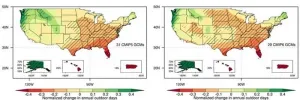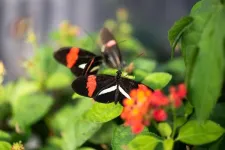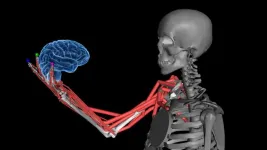(Press-News.org) For most people, reading about the difference between a global average temperature rise of 1.5 C versus 2 C doesn’t conjure up a clear image of how their daily lives will actually be affected. So, researchers at MIT have come up with a different way of measuring and describing what global climate change patterns, in specific regions around the world, will mean for people’s daily activities and their quality of life.
The new measure, called “outdoor days,” describes the number of days per year that outdoor temperatures are neither too hot nor too cold for people to go about normal outdoor activities, whether work or leisure, in reasonable comfort. Describing the impact of rising temperatures in those terms reveals some significant global disparities, the researchers say.
The findings are described in a research paper written by MIT professor of civil and environmental engineering Elfatih Eltahir and postdocs Yeon-Woo Choi and Muhammad Khalifa, and published in the Journal of Climate.
Eltahir says he got the idea for this new system during his hourlong daily walks in the Boston area. “That’s how I interface with the temperature every day,” he says. He found that there have been more winter days recently when he could walk comfortably than in past years. Originally from Sudan, he says that when he returned there for visits, the opposite was the case: In winter, the weather tends to be relatively comfortable, but the number of these clement winter days has been declining. “There are fewer days that are really suitable for outdoor activity,” Eltahir says.
Rather than predefine what constitutes an acceptable outdoor day, Eltahir and his co-authors created a website where users can set their own definition of the highest and lowest temperatures they consider comfortable for their outside activities, then click on a country within a world map, or a state within the U.S., and get a forecast of how the number of days meeting those criteria will change between now and the end of this century. The website is freely available for anyone to use.
“This is actually a new feature that’s quite innovative,” he says. “We don’t tell people what an outdoor day should be; we let the user define an outdoor day. Hence, we invite them to participate in defining how future climate change will impact their quality of life, and hopefully, this will facilitate deeper understanding of how climate change will impact individuals directly.”
After deciding that this was a way of looking at the issue of climate change that might be useful, Eltahir says, “we started looking at the data on this, and we made several discoveries that I think are pretty significant.”
First of all, there will be winners and losers, and the losers tend to be concentrated in the global south. “In the North, in a place like Russia or Canada, you gain a significant number of outdoor days. And when you go south to places like Bangladesh or Sudan, it’s bad news. You get significantly fewer outdoor days. It is very striking.”
To derive the data, the software developed by the team uses all of the available climate models, about 50 of them, and provides output showing all of those projections on a single graph to make clear the range of possibilities, as well as the average forecast.
When we think of climate change, Eltahir says, we tend to look at maps that show that virtually everywhere, temperatures will rise. “But if you think in terms of outdoor days, you see that the world is not flat. The North is gaining; the South is losing.”
While North-South disparity in exposure and vulnerability has been broadly recognized in the past, he says, this way of quantifying the effects on the hazard (change in weather patterns) helps to bring home how strong the uneven risks from climate change on quality of life will be. “When you look at places like Bangladesh, Colombia, Ivory Coast, Sudan, Indonesia — they are all losing outdoor days.”
The same kind of disparity shows up in Europe, he says. The effects are already being felt, and are showing up in travel patterns: “There is a shift to people spending time in northern European states. They go to Sweden and places like that instead of the Mediterranean, which is showing a significant drop,” he says.
Placing this kind of detailed and localized information at people’s fingertips, he says, “I think brings the issue of communication of climate change to a different level.” With this tool, instead of looking at global averages, “we are saying according to your own definition of what a pleasant day is, [this is] how climate change is going to impact you, your activities.”
And, he adds, “hopefully that will help society make decisions about what to do with this global challenge.”
The project received support from the MIT Climate Grand Challenges project and the Abdul Latif Jameel Water and Food Systems Lab.
###
Written by David Chandler, MIT News
Paper: “North-South disparity in impact of climate change on “outdoor days””
https://journals.ametsoc.org/view/journals/clim/aop/JCLI-D-23-0346.1/JCLI-D-23-0346.1.xml
END
A new way to quantify climate change impacts: “Outdoor days”
This measure, developed by MIT researchers, reflects direct effects on people’s quality of life — and reveals significant global disparities
2024-03-21
ELSE PRESS RELEASES FROM THIS DATE:
Scientists find core regulatory circuit controlling identity of aggressive leukemia
2024-03-21
A collaboration between scientists from St. Jude Children’s Research Hospital and Dana-Farber Cancer Institute uncovered four proteins that govern the identity of anaplastic large cell lymphoma (ALCL), an aggressive form of cancer. These proteins comprise a core regulatory circuit (CRC) that surprisingly incorporates a dysregulated signaling protein. Establishing the CRC for this lymphoma gives researchers insight into potential vulnerabilities that may be future therapeutic targets. The findings were published today in Cell Reports Medicine.
“Mutations in signaling pathways have long been known to drive oncogenic transformation ...
Organic fields increase pesticide use in nearby conventional fields, but reduce it in organic neighbors
2024-03-21
Expanding organic cropland can lead to increased pesticide use in surrounding conventional fields while reducing pesticide use on nearby organic fields, according to a study based in a leading U.S. crop-producing region. The findings provide insight into overlooked environmental impacts of organic agriculture and suggest that clustering organic fields could reduce pesticide use at the landscape scale. Organic agricultural practices are designed to have less negative local environmental impacts than other forms of intensive agriculture. However, the ...
Revealed: A gene underlying visual mating behaviors in Heliconius butterflies
2024-03-21
A particular gene plays a critical role in visual preference for mate choice between closely related Heliconius butterflies, according to a new study. The findings provide insight into how visually guided behaviors can be encoded within the genome. Many species use color and other visual cues to attract and recognize suitable mates. As such, visual preferences are important drivers of mate choice and sexual selection. However, while the genetics and evolution of the traits that serve as these cues – such as butterfly wing color – are ...
Novel approach yields better single-copy artificial human chromosomes
2024-03-21
Constructing human artificial chromosomes (HACs) in budding yeast overcomes the long-standing problem of uncontrolled multimerization – the rampant joining of similar molecules – and results in HACs that are large, stable, and structurally well-defined, researchers report. The findings may help advance chromosome engineering for precise genome editing in mammals and many other organisms. Artificial chromosomes can carry large numbers of engineered genes. Their use in bacteria and yeast as vehicles for writing and rewriting genomes has hinted at their potential to provide an alternative approach to editing genetic material in human cell lines. Although the first HACs were ...
A path forward from the “equity versus excellence” conflict that has impeded mathematics education in U.S.
2024-03-21
In a Policy Forum, Alan Schoenfeld and Phil Daro argue that the “equity versus excellence” controversy over how mathematics is taught has long disrupted education in the United States, particularly for underrepresented ethnic and socioeconomic groups. According to Schoenfeld and Daro, K-12 mathematics education in the U.S. is structured in ways that are problematic and do not reflect international trends. For more than 50 years, the typical yet rigid sequence of hierarchical mathematics courses – algebra 1 to geometry to algebra II to precalculus to calculus – has disenfranchised ...
How butterflies choose mates: gene controls preferences
2024-03-21
Tropical Heliconius butterflies are well known for the bright colour patterns on their wings. These striking colour patterns not only scare off predators – the butterflies are poisonous and are distasteful to birds – but are also important signals during mate selection. A team led by evolutionary biologist Richard Merrill from LMU Munich, in cooperation with researchers from the Universidad del Rosario in Bogotá (Colombia) and the Smithsonian Tropical Research Institute (Panama), has now exploited the diversity of warning patterns of various Heliconius species to investigate the genetic foundations of these preferences. ...
Mysterious exporter for brassinosteroid first identified
2024-03-21
When you are reading this article, there are multiple hormones working diligently inside your body to stabilize your health status. Same as human beings, it is impossible for plants to grow and reproduce without being regulated by phytohormones. One of the phytohormones is the Brassinosteroid (BR) hormones, also named as the sixth phytohormone.
According to a study published in Science on March 22, 2024, researchers led by Prof. SUN Linfeng from the Division of Life Sciences and Medicine of the University of Science and Technology ...
New reactor could save millions when making ingredients for plastics and rubber from natural gas
2024-03-21
Images
A new way to make an important ingredient for plastics, adhesives, carpet fibers, household cleaners and more from natural gas could reduce manufacturing costs in a post-petroleum economy by millions of dollars, thanks to a new chemical reactor designed by University of Michigan engineers.
The reactor creates propylene, a workhorse chemical that is also used to make a long list of industrial chemicals, including ingredients for nitrile rubber found in automotive hoses and seals as well as blue protective gloves. ...
How the brain senses body position and movement
2024-03-21
How does your brain know the position and movement of your different body parts? The sense is known as proprioception, and it is something like a “sixth sense”, allowing us to move freely without constantly watching our limbs.
Proprioception involves a complex network of sensors embedded in our muscles that relay information about limb position and movement back to our brain. However, little is known about how the brain puts together the different signals it receives from muscles.
A new study led by Alexander Mathis at EPFL now sheds light on the question by exploring how our brains create a cohesive sense of body position and movement. Published in Cell, ...
Species diversity promotes ecosystem stability
2024-03-21
Species diversity promotes ecosystem stability
Biodiversity loss may accelerate ecosystem destabilization
What maintains stability within an ecosystem and prevents a single best competitor from displacing other species from a community? Does ecosystem stability depend upon the presence of a wide variety of species, as early ecologists believed, or does diversity do the exact opposite, and lead to instability, as modern theory predicts?
Resolving a long-standing debate among ecologists
A new study from McGill University and ...
LAST 30 PRESS RELEASES:
Scalable and healable gradient textiles for multi‑scenario radiative cooling via bicomponent blow spinning
Research shows informed traders never let a good climate crisis go to waste
Intelligent XGBoost framework enhances asphalt pavement skid resistance assessment
Dual-function biomaterials for postoperative osteosarcoma: Tumor suppression and bone regeneration
New framework reveals where transport emissions concentrate in Singapore
NTP-enhanced lattice oxygen activation in Ce-Co catalysts for low-temperature soot combustion
Synergistic interface engineering in Cu-Zn-Ce catalysts for efficient CO2 hydrogenation to methanol
COVID-19 leaves a lasting mark on the human brain
Scientists use ultrasound to soften and treat cancer tumors without damaging healthy tissue
Community swimming program for Black youth boosts skills, sense of belonging, study finds
Specific depressive symptoms in midlife linked to increased dementia risk
An ‘illuminating’ design sheds light on cholesterol
Who is more likely to get long COVID?
Study showcases resilience and rapid growth of “living rocks”
Naval Research Lab diver earns Office of Naval Research 2025 Sailor of the Year
New Mayo-led study establishes practical definition for rapidly progressive dementia
Fossil fuel industry’s “climate false solutions” reinforce its power and aggravate environmental injustice
Researchers reveal bias in a widely used measure of algorithm performance
Alcohol causes cancer. A study from IOCB Prague confirms damage to DNA and shows how cells defend against it
Hidden viruses in wastewater treatment may shape public health risks, study finds
Unlock the power of nature: how biomass can transform climate mitigation
Biochar reshapes hidden soil microbes that capture carbon dioxide in farmland
Reducing saturated fat intake shows mortality benefit, but only in high-risk individuals
Manta rays create mobile ecosystems, study finds
Study: Mixed results in using lipoic acid to treat progressive multiple sclerosis
Norbert Holtkamp appointed director of Fermi National Accelerator Laboratory
New agentic AI platform accelerates advanced optics design
Biologists discover neurons use physical signals — not electricity — to stabilize communication
Researchers discover that a hormone can access the brain by hitchhiking
University of Oklahoma researcher awarded funding to pursue AI-powered material design
[Press-News.org] A new way to quantify climate change impacts: “Outdoor days”This measure, developed by MIT researchers, reflects direct effects on people’s quality of life — and reveals significant global disparities





